Report on Effective Workplace Coaching: Roles, Process, and Ethics
VerifiedAdded on 2022/09/07
|14
|3697
|48
Report
AI Summary
This report provides a comprehensive overview of effective workplace coaching, examining its context, roles, and responsibilities within an organization. It defines workplace coaching and its benefits, emphasizing the importance of an effective coach's behaviors and characteristics, including trustworthiness, confidence, and active listening. The report delves into the coaching process, utilizing the GROW model as a framework for managing coaching sessions and explores the range of tools and techniques that support effective coaching. Ethical considerations, such as maintaining confidentiality, are also discussed. The report highlights the significance of record-keeping and recognizing potential barriers to coaching, offering valuable insights for anyone involved in workplace coaching and leadership development.
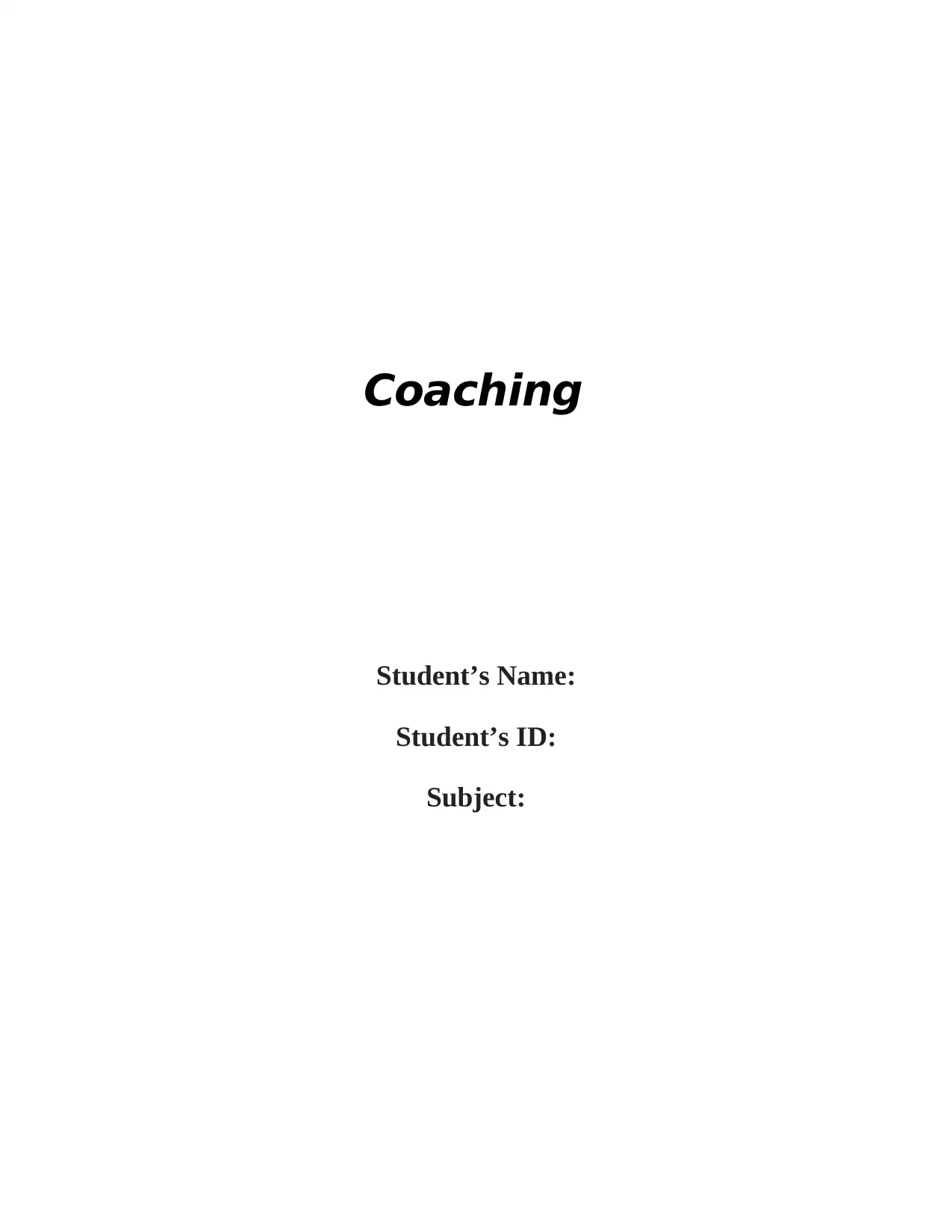
Coaching
Student’s Name:
Student’s ID:
Subject:
Student’s Name:
Student’s ID:
Subject:
Paraphrase This Document
Need a fresh take? Get an instant paraphrase of this document with our AI Paraphraser

1
Table of Contents
Introduction.................................................................................................................................................2
Section 1 Understanding the context for effective workplace coaching......................................................2
AC 1.1 Workplace coaching....................................................................................................................2
AC 1.2 Roles and responsibilities of the effective workplace coach........................................................3
AC 1.3 Behaviors and characteristics of an effective workplace coach...................................................5
AC 1.4 Coaches should contract and manage confidentiality to coach ethically.....................................6
Section 2 Understanding the process and content of effective workplace coaching....................................7
AC 2.1 Managing a coaching process using a Coaching model...............................................................7
AC 2.2 Range of tools and techniques that can be used to support effective coaching............................8
AC 2.3 Importance of maintaining basic records of coaching activity.....................................................9
AC 2.4 Recognising potential barriers to coaching in the workplace.....................................................10
Conclusion.................................................................................................................................................12
References.................................................................................................................................................13
Table of Contents
Introduction.................................................................................................................................................2
Section 1 Understanding the context for effective workplace coaching......................................................2
AC 1.1 Workplace coaching....................................................................................................................2
AC 1.2 Roles and responsibilities of the effective workplace coach........................................................3
AC 1.3 Behaviors and characteristics of an effective workplace coach...................................................5
AC 1.4 Coaches should contract and manage confidentiality to coach ethically.....................................6
Section 2 Understanding the process and content of effective workplace coaching....................................7
AC 2.1 Managing a coaching process using a Coaching model...............................................................7
AC 2.2 Range of tools and techniques that can be used to support effective coaching............................8
AC 2.3 Importance of maintaining basic records of coaching activity.....................................................9
AC 2.4 Recognising potential barriers to coaching in the workplace.....................................................10
Conclusion.................................................................................................................................................12
References.................................................................................................................................................13
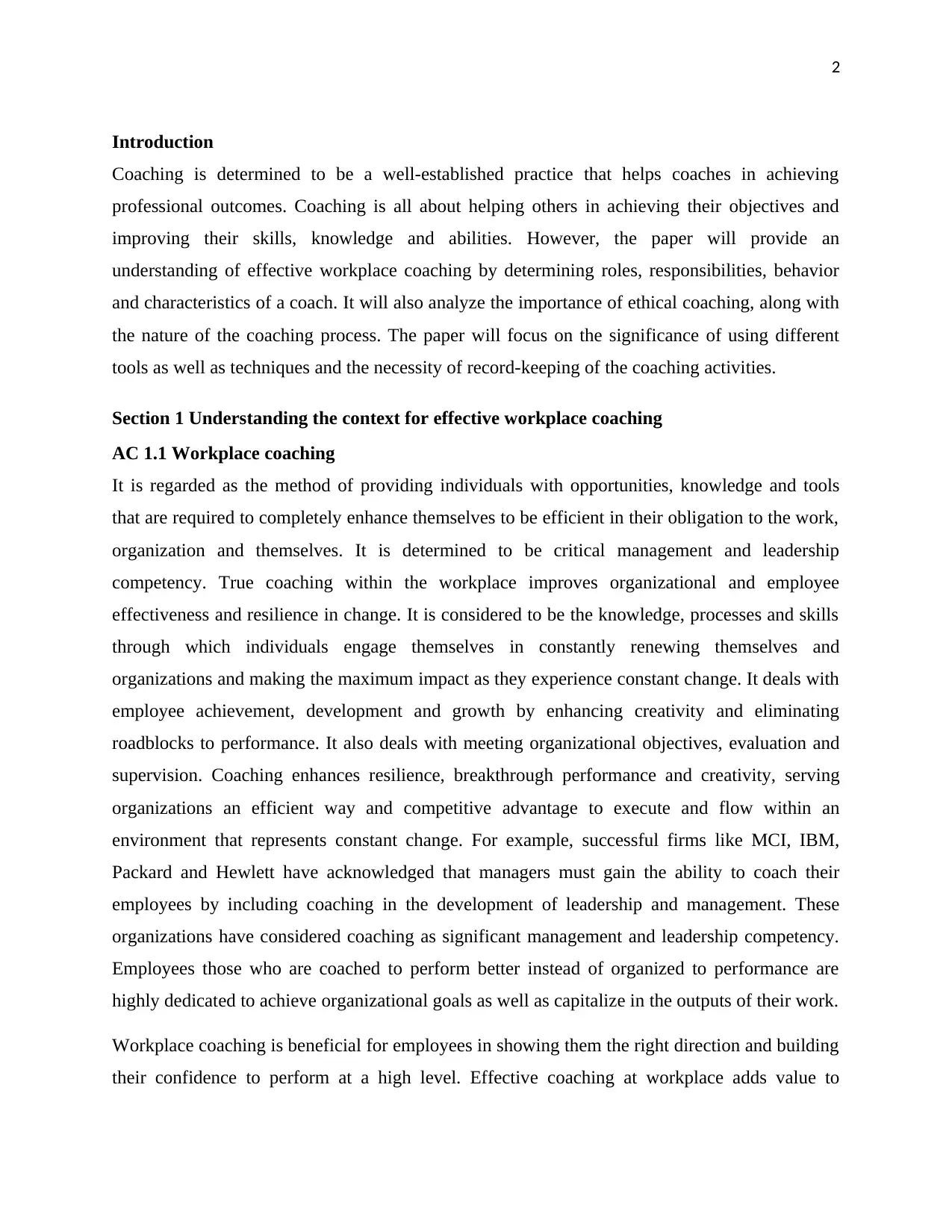
2
Introduction
Coaching is determined to be a well-established practice that helps coaches in achieving
professional outcomes. Coaching is all about helping others in achieving their objectives and
improving their skills, knowledge and abilities. However, the paper will provide an
understanding of effective workplace coaching by determining roles, responsibilities, behavior
and characteristics of a coach. It will also analyze the importance of ethical coaching, along with
the nature of the coaching process. The paper will focus on the significance of using different
tools as well as techniques and the necessity of record-keeping of the coaching activities.
Section 1 Understanding the context for effective workplace coaching
AC 1.1 Workplace coaching
It is regarded as the method of providing individuals with opportunities, knowledge and tools
that are required to completely enhance themselves to be efficient in their obligation to the work,
organization and themselves. It is determined to be critical management and leadership
competency. True coaching within the workplace improves organizational and employee
effectiveness and resilience in change. It is considered to be the knowledge, processes and skills
through which individuals engage themselves in constantly renewing themselves and
organizations and making the maximum impact as they experience constant change. It deals with
employee achievement, development and growth by enhancing creativity and eliminating
roadblocks to performance. It also deals with meeting organizational objectives, evaluation and
supervision. Coaching enhances resilience, breakthrough performance and creativity, serving
organizations an efficient way and competitive advantage to execute and flow within an
environment that represents constant change. For example, successful firms like MCI, IBM,
Packard and Hewlett have acknowledged that managers must gain the ability to coach their
employees by including coaching in the development of leadership and management. These
organizations have considered coaching as significant management and leadership competency.
Employees those who are coached to perform better instead of organized to performance are
highly dedicated to achieve organizational goals as well as capitalize in the outputs of their work.
Workplace coaching is beneficial for employees in showing them the right direction and building
their confidence to perform at a high level. Effective coaching at workplace adds value to
Introduction
Coaching is determined to be a well-established practice that helps coaches in achieving
professional outcomes. Coaching is all about helping others in achieving their objectives and
improving their skills, knowledge and abilities. However, the paper will provide an
understanding of effective workplace coaching by determining roles, responsibilities, behavior
and characteristics of a coach. It will also analyze the importance of ethical coaching, along with
the nature of the coaching process. The paper will focus on the significance of using different
tools as well as techniques and the necessity of record-keeping of the coaching activities.
Section 1 Understanding the context for effective workplace coaching
AC 1.1 Workplace coaching
It is regarded as the method of providing individuals with opportunities, knowledge and tools
that are required to completely enhance themselves to be efficient in their obligation to the work,
organization and themselves. It is determined to be critical management and leadership
competency. True coaching within the workplace improves organizational and employee
effectiveness and resilience in change. It is considered to be the knowledge, processes and skills
through which individuals engage themselves in constantly renewing themselves and
organizations and making the maximum impact as they experience constant change. It deals with
employee achievement, development and growth by enhancing creativity and eliminating
roadblocks to performance. It also deals with meeting organizational objectives, evaluation and
supervision. Coaching enhances resilience, breakthrough performance and creativity, serving
organizations an efficient way and competitive advantage to execute and flow within an
environment that represents constant change. For example, successful firms like MCI, IBM,
Packard and Hewlett have acknowledged that managers must gain the ability to coach their
employees by including coaching in the development of leadership and management. These
organizations have considered coaching as significant management and leadership competency.
Employees those who are coached to perform better instead of organized to performance are
highly dedicated to achieve organizational goals as well as capitalize in the outputs of their work.
Workplace coaching is beneficial for employees in showing them the right direction and building
their confidence to perform at a high level. Effective coaching at workplace adds value to
⊘ This is a preview!⊘
Do you want full access?
Subscribe today to unlock all pages.

Trusted by 1+ million students worldwide
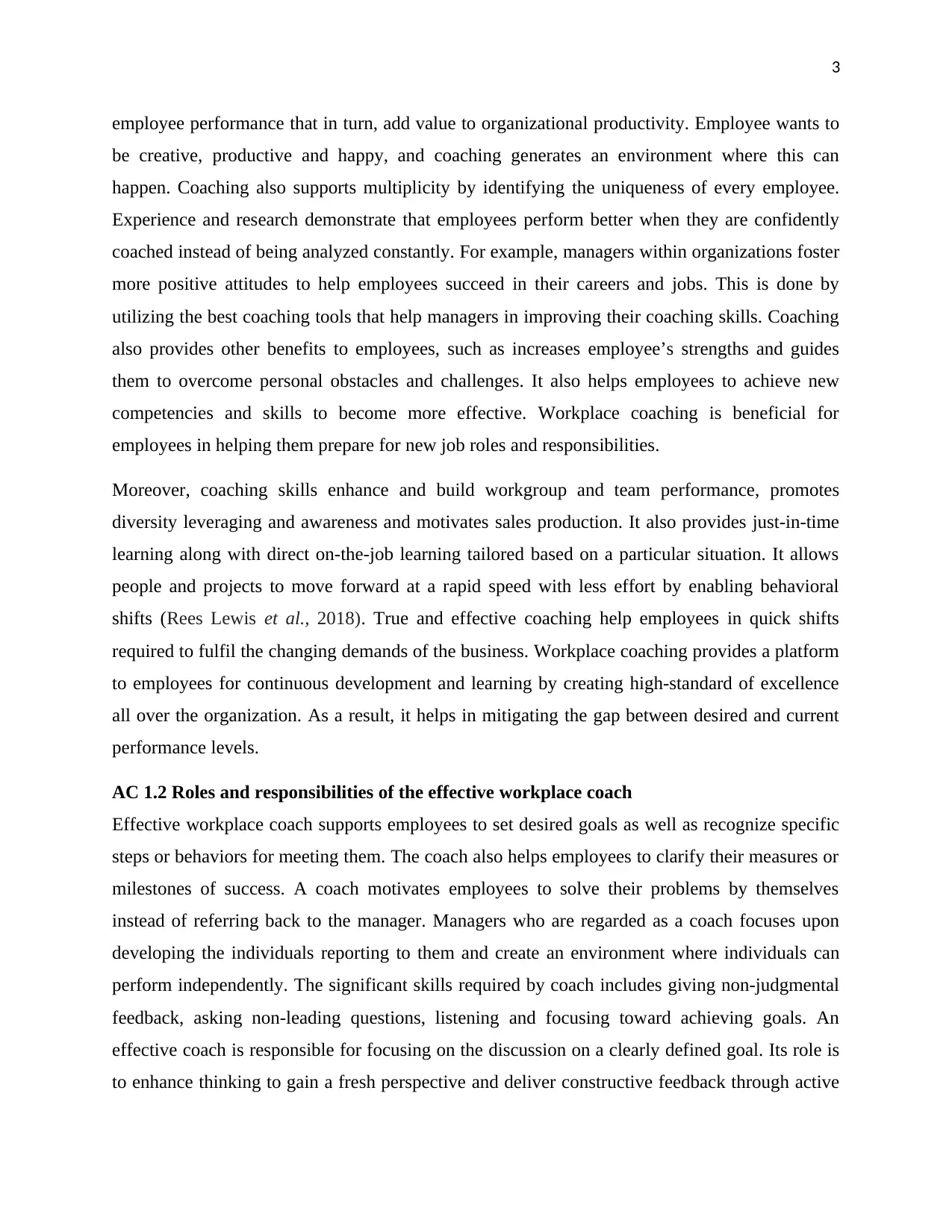
3
employee performance that in turn, add value to organizational productivity. Employee wants to
be creative, productive and happy, and coaching generates an environment where this can
happen. Coaching also supports multiplicity by identifying the uniqueness of every employee.
Experience and research demonstrate that employees perform better when they are confidently
coached instead of being analyzed constantly. For example, managers within organizations foster
more positive attitudes to help employees succeed in their careers and jobs. This is done by
utilizing the best coaching tools that help managers in improving their coaching skills. Coaching
also provides other benefits to employees, such as increases employee’s strengths and guides
them to overcome personal obstacles and challenges. It also helps employees to achieve new
competencies and skills to become more effective. Workplace coaching is beneficial for
employees in helping them prepare for new job roles and responsibilities.
Moreover, coaching skills enhance and build workgroup and team performance, promotes
diversity leveraging and awareness and motivates sales production. It also provides just-in-time
learning along with direct on-the-job learning tailored based on a particular situation. It allows
people and projects to move forward at a rapid speed with less effort by enabling behavioral
shifts (Rees Lewis et al., 2018). True and effective coaching help employees in quick shifts
required to fulfil the changing demands of the business. Workplace coaching provides a platform
to employees for continuous development and learning by creating high-standard of excellence
all over the organization. As a result, it helps in mitigating the gap between desired and current
performance levels.
AC 1.2 Roles and responsibilities of the effective workplace coach
Effective workplace coach supports employees to set desired goals as well as recognize specific
steps or behaviors for meeting them. The coach also helps employees to clarify their measures or
milestones of success. A coach motivates employees to solve their problems by themselves
instead of referring back to the manager. Managers who are regarded as a coach focuses upon
developing the individuals reporting to them and create an environment where individuals can
perform independently. The significant skills required by coach includes giving non-judgmental
feedback, asking non-leading questions, listening and focusing toward achieving goals. An
effective coach is responsible for focusing on the discussion on a clearly defined goal. Its role is
to enhance thinking to gain a fresh perspective and deliver constructive feedback through active
employee performance that in turn, add value to organizational productivity. Employee wants to
be creative, productive and happy, and coaching generates an environment where this can
happen. Coaching also supports multiplicity by identifying the uniqueness of every employee.
Experience and research demonstrate that employees perform better when they are confidently
coached instead of being analyzed constantly. For example, managers within organizations foster
more positive attitudes to help employees succeed in their careers and jobs. This is done by
utilizing the best coaching tools that help managers in improving their coaching skills. Coaching
also provides other benefits to employees, such as increases employee’s strengths and guides
them to overcome personal obstacles and challenges. It also helps employees to achieve new
competencies and skills to become more effective. Workplace coaching is beneficial for
employees in helping them prepare for new job roles and responsibilities.
Moreover, coaching skills enhance and build workgroup and team performance, promotes
diversity leveraging and awareness and motivates sales production. It also provides just-in-time
learning along with direct on-the-job learning tailored based on a particular situation. It allows
people and projects to move forward at a rapid speed with less effort by enabling behavioral
shifts (Rees Lewis et al., 2018). True and effective coaching help employees in quick shifts
required to fulfil the changing demands of the business. Workplace coaching provides a platform
to employees for continuous development and learning by creating high-standard of excellence
all over the organization. As a result, it helps in mitigating the gap between desired and current
performance levels.
AC 1.2 Roles and responsibilities of the effective workplace coach
Effective workplace coach supports employees to set desired goals as well as recognize specific
steps or behaviors for meeting them. The coach also helps employees to clarify their measures or
milestones of success. A coach motivates employees to solve their problems by themselves
instead of referring back to the manager. Managers who are regarded as a coach focuses upon
developing the individuals reporting to them and create an environment where individuals can
perform independently. The significant skills required by coach includes giving non-judgmental
feedback, asking non-leading questions, listening and focusing toward achieving goals. An
effective coach is responsible for focusing on the discussion on a clearly defined goal. Its role is
to enhance thinking to gain a fresh perspective and deliver constructive feedback through active
Paraphrase This Document
Need a fresh take? Get an instant paraphrase of this document with our AI Paraphraser
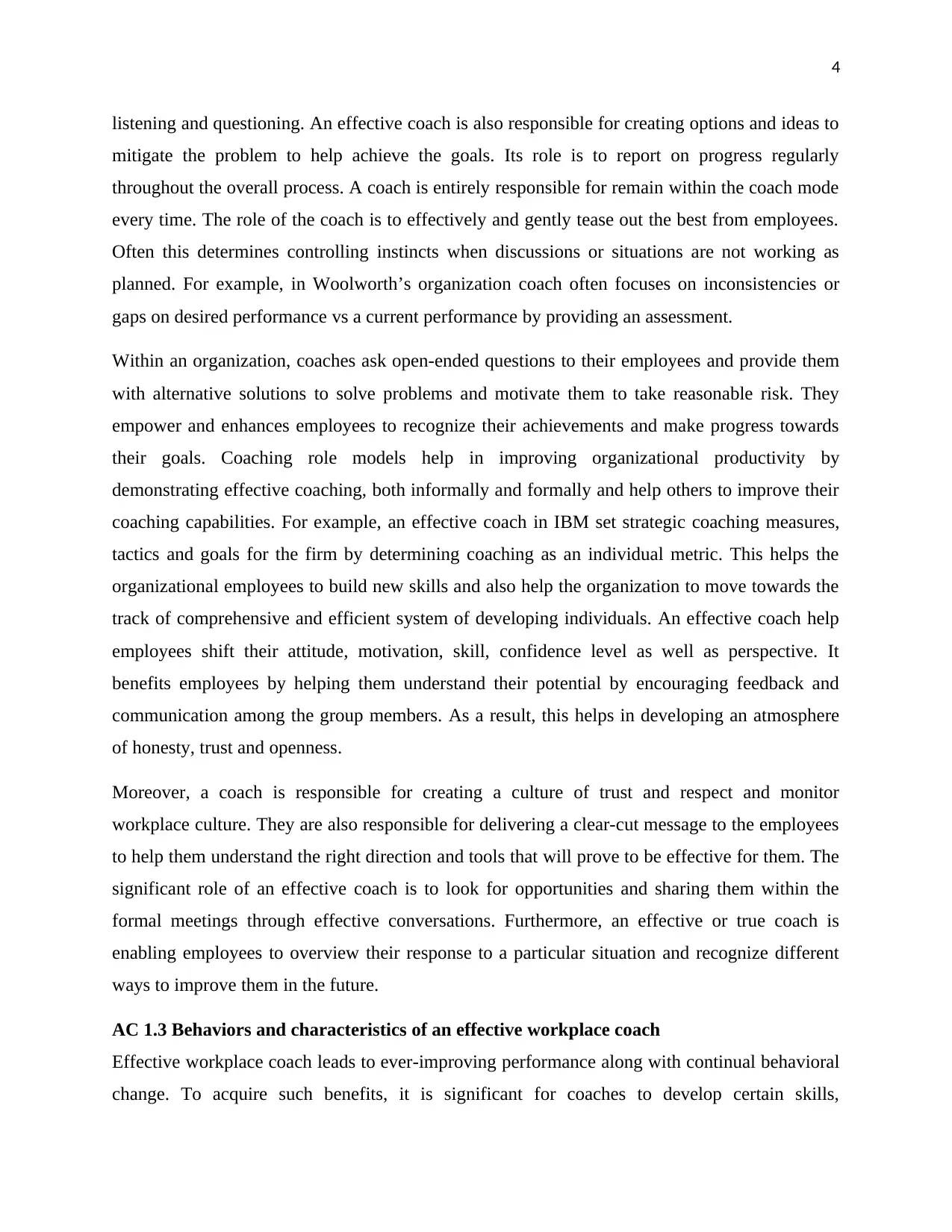
4
listening and questioning. An effective coach is also responsible for creating options and ideas to
mitigate the problem to help achieve the goals. Its role is to report on progress regularly
throughout the overall process. A coach is entirely responsible for remain within the coach mode
every time. The role of the coach is to effectively and gently tease out the best from employees.
Often this determines controlling instincts when discussions or situations are not working as
planned. For example, in Woolworth’s organization coach often focuses on inconsistencies or
gaps on desired performance vs a current performance by providing an assessment.
Within an organization, coaches ask open-ended questions to their employees and provide them
with alternative solutions to solve problems and motivate them to take reasonable risk. They
empower and enhances employees to recognize their achievements and make progress towards
their goals. Coaching role models help in improving organizational productivity by
demonstrating effective coaching, both informally and formally and help others to improve their
coaching capabilities. For example, an effective coach in IBM set strategic coaching measures,
tactics and goals for the firm by determining coaching as an individual metric. This helps the
organizational employees to build new skills and also help the organization to move towards the
track of comprehensive and efficient system of developing individuals. An effective coach help
employees shift their attitude, motivation, skill, confidence level as well as perspective. It
benefits employees by helping them understand their potential by encouraging feedback and
communication among the group members. As a result, this helps in developing an atmosphere
of honesty, trust and openness.
Moreover, a coach is responsible for creating a culture of trust and respect and monitor
workplace culture. They are also responsible for delivering a clear-cut message to the employees
to help them understand the right direction and tools that will prove to be effective for them. The
significant role of an effective coach is to look for opportunities and sharing them within the
formal meetings through effective conversations. Furthermore, an effective or true coach is
enabling employees to overview their response to a particular situation and recognize different
ways to improve them in the future.
AC 1.3 Behaviors and characteristics of an effective workplace coach
Effective workplace coach leads to ever-improving performance along with continual behavioral
change. To acquire such benefits, it is significant for coaches to develop certain skills,
listening and questioning. An effective coach is also responsible for creating options and ideas to
mitigate the problem to help achieve the goals. Its role is to report on progress regularly
throughout the overall process. A coach is entirely responsible for remain within the coach mode
every time. The role of the coach is to effectively and gently tease out the best from employees.
Often this determines controlling instincts when discussions or situations are not working as
planned. For example, in Woolworth’s organization coach often focuses on inconsistencies or
gaps on desired performance vs a current performance by providing an assessment.
Within an organization, coaches ask open-ended questions to their employees and provide them
with alternative solutions to solve problems and motivate them to take reasonable risk. They
empower and enhances employees to recognize their achievements and make progress towards
their goals. Coaching role models help in improving organizational productivity by
demonstrating effective coaching, both informally and formally and help others to improve their
coaching capabilities. For example, an effective coach in IBM set strategic coaching measures,
tactics and goals for the firm by determining coaching as an individual metric. This helps the
organizational employees to build new skills and also help the organization to move towards the
track of comprehensive and efficient system of developing individuals. An effective coach help
employees shift their attitude, motivation, skill, confidence level as well as perspective. It
benefits employees by helping them understand their potential by encouraging feedback and
communication among the group members. As a result, this helps in developing an atmosphere
of honesty, trust and openness.
Moreover, a coach is responsible for creating a culture of trust and respect and monitor
workplace culture. They are also responsible for delivering a clear-cut message to the employees
to help them understand the right direction and tools that will prove to be effective for them. The
significant role of an effective coach is to look for opportunities and sharing them within the
formal meetings through effective conversations. Furthermore, an effective or true coach is
enabling employees to overview their response to a particular situation and recognize different
ways to improve them in the future.
AC 1.3 Behaviors and characteristics of an effective workplace coach
Effective workplace coach leads to ever-improving performance along with continual behavioral
change. To acquire such benefits, it is significant for coaches to develop certain skills,
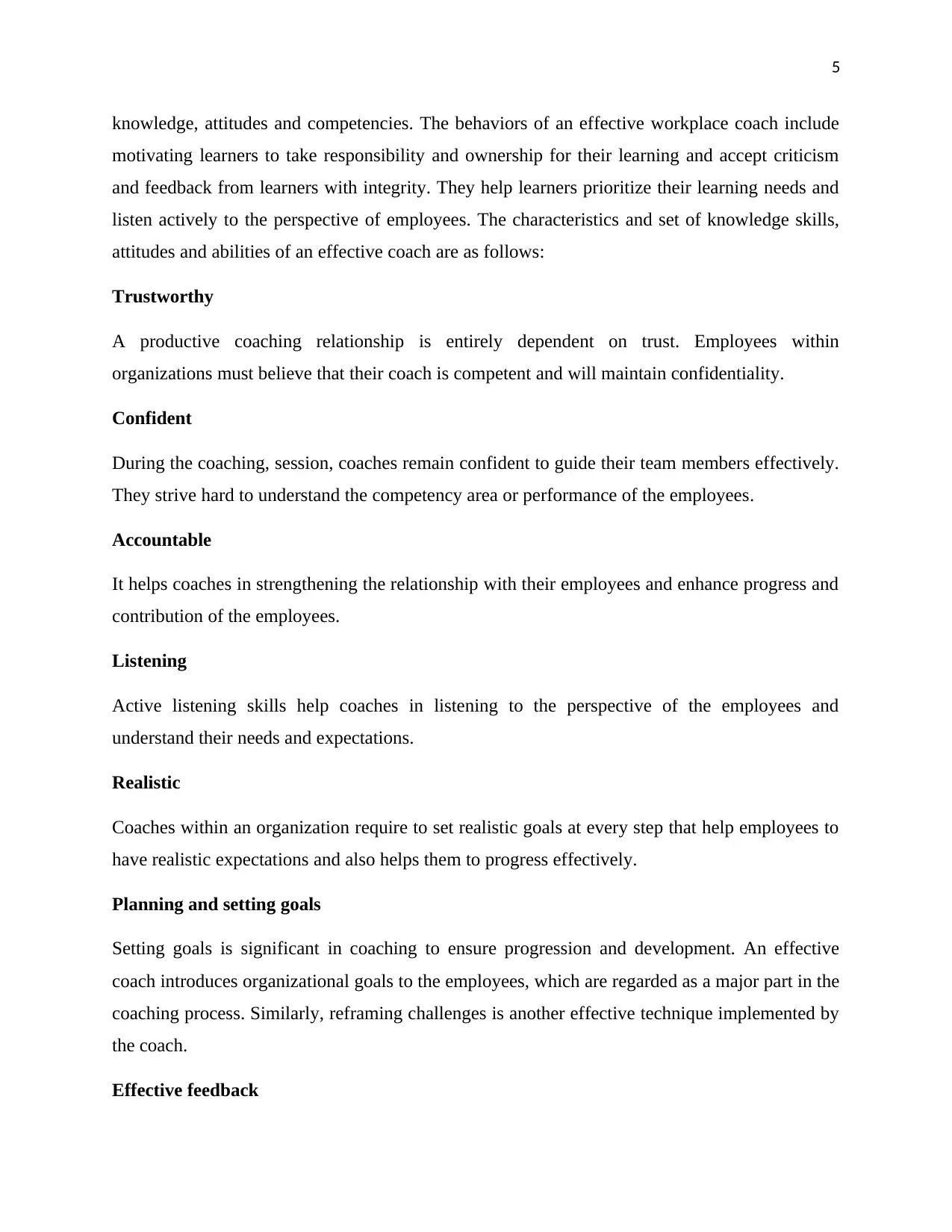
5
knowledge, attitudes and competencies. The behaviors of an effective workplace coach include
motivating learners to take responsibility and ownership for their learning and accept criticism
and feedback from learners with integrity. They help learners prioritize their learning needs and
listen actively to the perspective of employees. The characteristics and set of knowledge skills,
attitudes and abilities of an effective coach are as follows:
Trustworthy
A productive coaching relationship is entirely dependent on trust. Employees within
organizations must believe that their coach is competent and will maintain confidentiality.
Confident
During the coaching, session, coaches remain confident to guide their team members effectively.
They strive hard to understand the competency area or performance of the employees.
Accountable
It helps coaches in strengthening the relationship with their employees and enhance progress and
contribution of the employees.
Listening
Active listening skills help coaches in listening to the perspective of the employees and
understand their needs and expectations.
Realistic
Coaches within an organization require to set realistic goals at every step that help employees to
have realistic expectations and also helps them to progress effectively.
Planning and setting goals
Setting goals is significant in coaching to ensure progression and development. An effective
coach introduces organizational goals to the employees, which are regarded as a major part in the
coaching process. Similarly, reframing challenges is another effective technique implemented by
the coach.
Effective feedback
knowledge, attitudes and competencies. The behaviors of an effective workplace coach include
motivating learners to take responsibility and ownership for their learning and accept criticism
and feedback from learners with integrity. They help learners prioritize their learning needs and
listen actively to the perspective of employees. The characteristics and set of knowledge skills,
attitudes and abilities of an effective coach are as follows:
Trustworthy
A productive coaching relationship is entirely dependent on trust. Employees within
organizations must believe that their coach is competent and will maintain confidentiality.
Confident
During the coaching, session, coaches remain confident to guide their team members effectively.
They strive hard to understand the competency area or performance of the employees.
Accountable
It helps coaches in strengthening the relationship with their employees and enhance progress and
contribution of the employees.
Listening
Active listening skills help coaches in listening to the perspective of the employees and
understand their needs and expectations.
Realistic
Coaches within an organization require to set realistic goals at every step that help employees to
have realistic expectations and also helps them to progress effectively.
Planning and setting goals
Setting goals is significant in coaching to ensure progression and development. An effective
coach introduces organizational goals to the employees, which are regarded as a major part in the
coaching process. Similarly, reframing challenges is another effective technique implemented by
the coach.
Effective feedback
⊘ This is a preview!⊘
Do you want full access?
Subscribe today to unlock all pages.

Trusted by 1+ million students worldwide
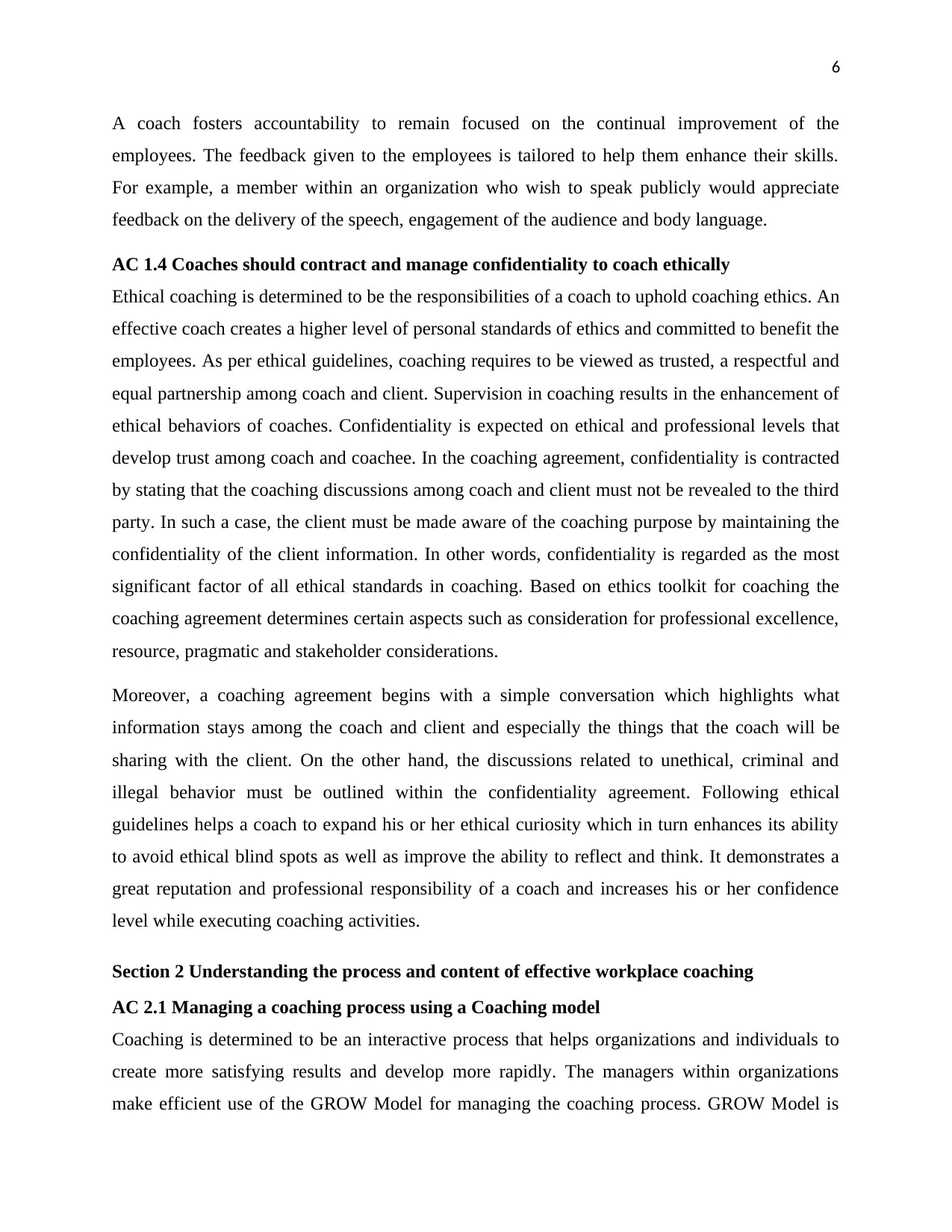
6
A coach fosters accountability to remain focused on the continual improvement of the
employees. The feedback given to the employees is tailored to help them enhance their skills.
For example, a member within an organization who wish to speak publicly would appreciate
feedback on the delivery of the speech, engagement of the audience and body language.
AC 1.4 Coaches should contract and manage confidentiality to coach ethically
Ethical coaching is determined to be the responsibilities of a coach to uphold coaching ethics. An
effective coach creates a higher level of personal standards of ethics and committed to benefit the
employees. As per ethical guidelines, coaching requires to be viewed as trusted, a respectful and
equal partnership among coach and client. Supervision in coaching results in the enhancement of
ethical behaviors of coaches. Confidentiality is expected on ethical and professional levels that
develop trust among coach and coachee. In the coaching agreement, confidentiality is contracted
by stating that the coaching discussions among coach and client must not be revealed to the third
party. In such a case, the client must be made aware of the coaching purpose by maintaining the
confidentiality of the client information. In other words, confidentiality is regarded as the most
significant factor of all ethical standards in coaching. Based on ethics toolkit for coaching the
coaching agreement determines certain aspects such as consideration for professional excellence,
resource, pragmatic and stakeholder considerations.
Moreover, a coaching agreement begins with a simple conversation which highlights what
information stays among the coach and client and especially the things that the coach will be
sharing with the client. On the other hand, the discussions related to unethical, criminal and
illegal behavior must be outlined within the confidentiality agreement. Following ethical
guidelines helps a coach to expand his or her ethical curiosity which in turn enhances its ability
to avoid ethical blind spots as well as improve the ability to reflect and think. It demonstrates a
great reputation and professional responsibility of a coach and increases his or her confidence
level while executing coaching activities.
Section 2 Understanding the process and content of effective workplace coaching
AC 2.1 Managing a coaching process using a Coaching model
Coaching is determined to be an interactive process that helps organizations and individuals to
create more satisfying results and develop more rapidly. The managers within organizations
make efficient use of the GROW Model for managing the coaching process. GROW Model is
A coach fosters accountability to remain focused on the continual improvement of the
employees. The feedback given to the employees is tailored to help them enhance their skills.
For example, a member within an organization who wish to speak publicly would appreciate
feedback on the delivery of the speech, engagement of the audience and body language.
AC 1.4 Coaches should contract and manage confidentiality to coach ethically
Ethical coaching is determined to be the responsibilities of a coach to uphold coaching ethics. An
effective coach creates a higher level of personal standards of ethics and committed to benefit the
employees. As per ethical guidelines, coaching requires to be viewed as trusted, a respectful and
equal partnership among coach and client. Supervision in coaching results in the enhancement of
ethical behaviors of coaches. Confidentiality is expected on ethical and professional levels that
develop trust among coach and coachee. In the coaching agreement, confidentiality is contracted
by stating that the coaching discussions among coach and client must not be revealed to the third
party. In such a case, the client must be made aware of the coaching purpose by maintaining the
confidentiality of the client information. In other words, confidentiality is regarded as the most
significant factor of all ethical standards in coaching. Based on ethics toolkit for coaching the
coaching agreement determines certain aspects such as consideration for professional excellence,
resource, pragmatic and stakeholder considerations.
Moreover, a coaching agreement begins with a simple conversation which highlights what
information stays among the coach and client and especially the things that the coach will be
sharing with the client. On the other hand, the discussions related to unethical, criminal and
illegal behavior must be outlined within the confidentiality agreement. Following ethical
guidelines helps a coach to expand his or her ethical curiosity which in turn enhances its ability
to avoid ethical blind spots as well as improve the ability to reflect and think. It demonstrates a
great reputation and professional responsibility of a coach and increases his or her confidence
level while executing coaching activities.
Section 2 Understanding the process and content of effective workplace coaching
AC 2.1 Managing a coaching process using a Coaching model
Coaching is determined to be an interactive process that helps organizations and individuals to
create more satisfying results and develop more rapidly. The managers within organizations
make efficient use of the GROW Model for managing the coaching process. GROW Model is
Paraphrase This Document
Need a fresh take? Get an instant paraphrase of this document with our AI Paraphraser
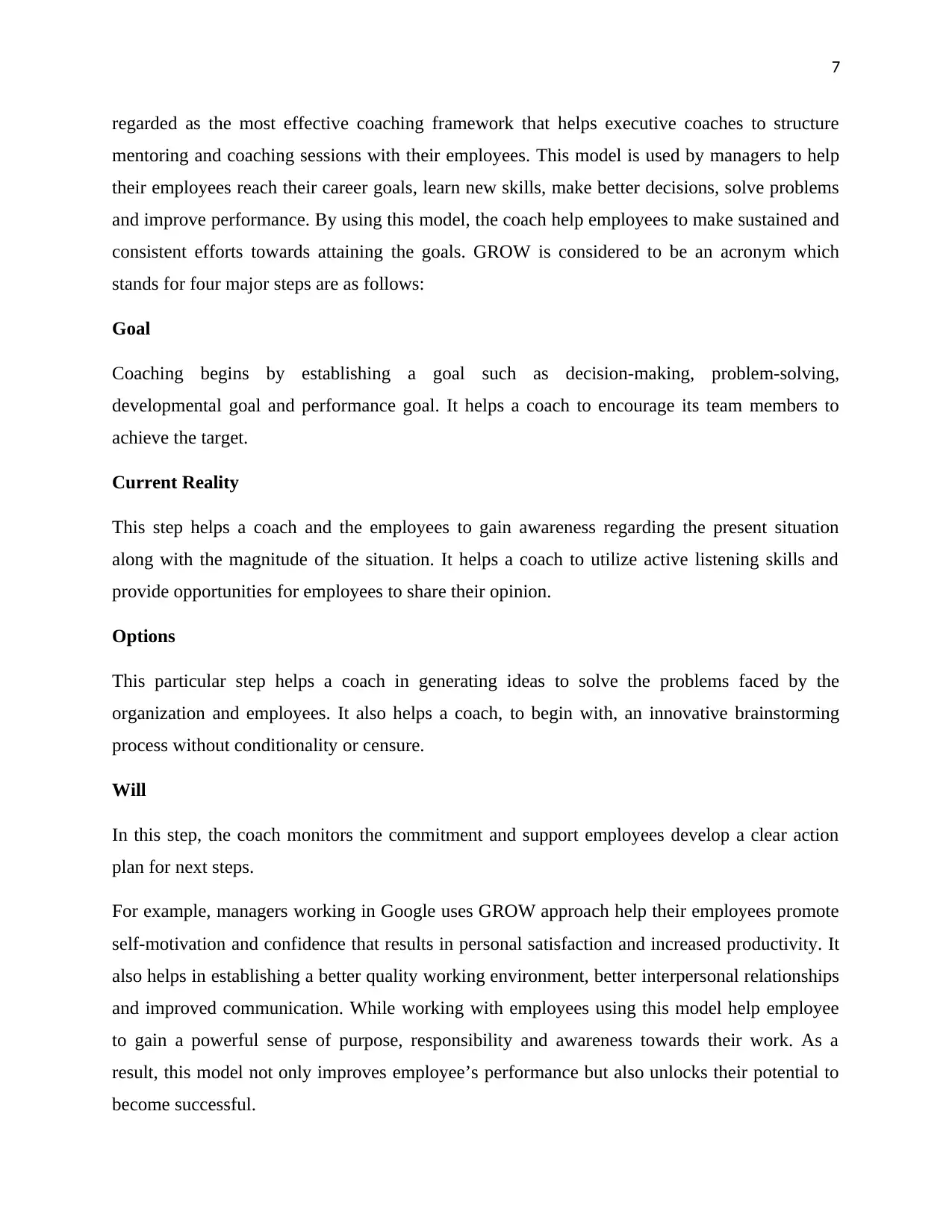
7
regarded as the most effective coaching framework that helps executive coaches to structure
mentoring and coaching sessions with their employees. This model is used by managers to help
their employees reach their career goals, learn new skills, make better decisions, solve problems
and improve performance. By using this model, the coach help employees to make sustained and
consistent efforts towards attaining the goals. GROW is considered to be an acronym which
stands for four major steps are as follows:
Goal
Coaching begins by establishing a goal such as decision-making, problem-solving,
developmental goal and performance goal. It helps a coach to encourage its team members to
achieve the target.
Current Reality
This step helps a coach and the employees to gain awareness regarding the present situation
along with the magnitude of the situation. It helps a coach to utilize active listening skills and
provide opportunities for employees to share their opinion.
Options
This particular step helps a coach in generating ideas to solve the problems faced by the
organization and employees. It also helps a coach, to begin with, an innovative brainstorming
process without conditionality or censure.
Will
In this step, the coach monitors the commitment and support employees develop a clear action
plan for next steps.
For example, managers working in Google uses GROW approach help their employees promote
self-motivation and confidence that results in personal satisfaction and increased productivity. It
also helps in establishing a better quality working environment, better interpersonal relationships
and improved communication. While working with employees using this model help employee
to gain a powerful sense of purpose, responsibility and awareness towards their work. As a
result, this model not only improves employee’s performance but also unlocks their potential to
become successful.
regarded as the most effective coaching framework that helps executive coaches to structure
mentoring and coaching sessions with their employees. This model is used by managers to help
their employees reach their career goals, learn new skills, make better decisions, solve problems
and improve performance. By using this model, the coach help employees to make sustained and
consistent efforts towards attaining the goals. GROW is considered to be an acronym which
stands for four major steps are as follows:
Goal
Coaching begins by establishing a goal such as decision-making, problem-solving,
developmental goal and performance goal. It helps a coach to encourage its team members to
achieve the target.
Current Reality
This step helps a coach and the employees to gain awareness regarding the present situation
along with the magnitude of the situation. It helps a coach to utilize active listening skills and
provide opportunities for employees to share their opinion.
Options
This particular step helps a coach in generating ideas to solve the problems faced by the
organization and employees. It also helps a coach, to begin with, an innovative brainstorming
process without conditionality or censure.
Will
In this step, the coach monitors the commitment and support employees develop a clear action
plan for next steps.
For example, managers working in Google uses GROW approach help their employees promote
self-motivation and confidence that results in personal satisfaction and increased productivity. It
also helps in establishing a better quality working environment, better interpersonal relationships
and improved communication. While working with employees using this model help employee
to gain a powerful sense of purpose, responsibility and awareness towards their work. As a
result, this model not only improves employee’s performance but also unlocks their potential to
become successful.
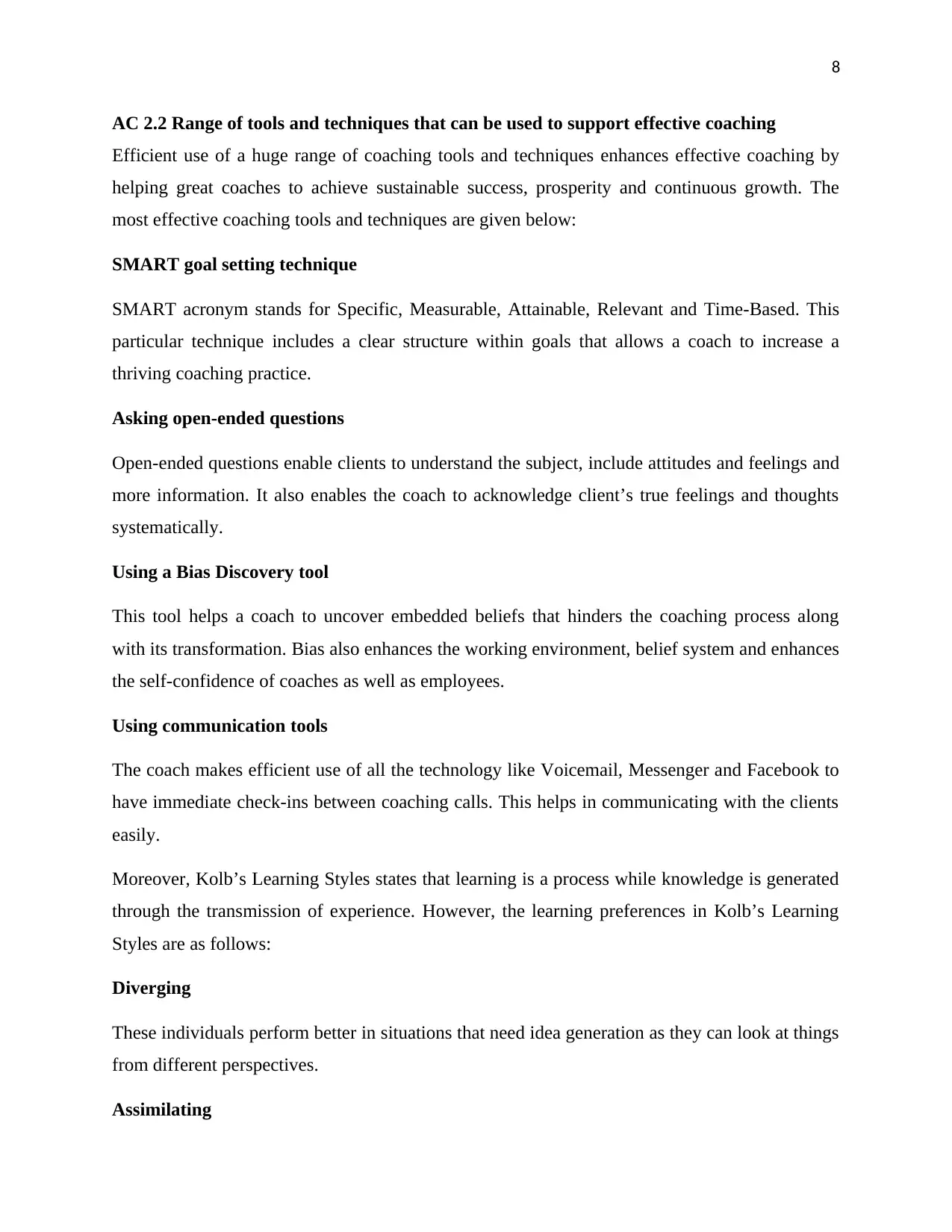
8
AC 2.2 Range of tools and techniques that can be used to support effective coaching
Efficient use of a huge range of coaching tools and techniques enhances effective coaching by
helping great coaches to achieve sustainable success, prosperity and continuous growth. The
most effective coaching tools and techniques are given below:
SMART goal setting technique
SMART acronym stands for Specific, Measurable, Attainable, Relevant and Time-Based. This
particular technique includes a clear structure within goals that allows a coach to increase a
thriving coaching practice.
Asking open-ended questions
Open-ended questions enable clients to understand the subject, include attitudes and feelings and
more information. It also enables the coach to acknowledge client’s true feelings and thoughts
systematically.
Using a Bias Discovery tool
This tool helps a coach to uncover embedded beliefs that hinders the coaching process along
with its transformation. Bias also enhances the working environment, belief system and enhances
the self-confidence of coaches as well as employees.
Using communication tools
The coach makes efficient use of all the technology like Voicemail, Messenger and Facebook to
have immediate check-ins between coaching calls. This helps in communicating with the clients
easily.
Moreover, Kolb’s Learning Styles states that learning is a process while knowledge is generated
through the transmission of experience. However, the learning preferences in Kolb’s Learning
Styles are as follows:
Diverging
These individuals perform better in situations that need idea generation as they can look at things
from different perspectives.
Assimilating
AC 2.2 Range of tools and techniques that can be used to support effective coaching
Efficient use of a huge range of coaching tools and techniques enhances effective coaching by
helping great coaches to achieve sustainable success, prosperity and continuous growth. The
most effective coaching tools and techniques are given below:
SMART goal setting technique
SMART acronym stands for Specific, Measurable, Attainable, Relevant and Time-Based. This
particular technique includes a clear structure within goals that allows a coach to increase a
thriving coaching practice.
Asking open-ended questions
Open-ended questions enable clients to understand the subject, include attitudes and feelings and
more information. It also enables the coach to acknowledge client’s true feelings and thoughts
systematically.
Using a Bias Discovery tool
This tool helps a coach to uncover embedded beliefs that hinders the coaching process along
with its transformation. Bias also enhances the working environment, belief system and enhances
the self-confidence of coaches as well as employees.
Using communication tools
The coach makes efficient use of all the technology like Voicemail, Messenger and Facebook to
have immediate check-ins between coaching calls. This helps in communicating with the clients
easily.
Moreover, Kolb’s Learning Styles states that learning is a process while knowledge is generated
through the transmission of experience. However, the learning preferences in Kolb’s Learning
Styles are as follows:
Diverging
These individuals perform better in situations that need idea generation as they can look at things
from different perspectives.
Assimilating
⊘ This is a preview!⊘
Do you want full access?
Subscribe today to unlock all pages.

Trusted by 1+ million students worldwide

9
These individuals need clear explanation instead of practical opportunity by considering the
logical approach.
Converging
These individuals can solve problems by finding practical solutions by utilizing practical theories
and ideas.
Accommodating
These people depend on intuition instead of logic and prefer to adopt an experimental and
practical approach.
It can be said that all these learning preferences play a major role in the coaching process by
helping coaches in making appropriate decisions, solving problems, finding relevant solutions
and developing a new learning style (Bommelje, 2015). The preferences also help a coach to
understand human learning behavior and helping others to learn.
AC 2.3 Importance of maintaining basic records of coaching activity
In coaching, record-keeping play a significant role for the coach and the employees to keep track
of the goals they set, conversations they have and the actions they are committed to
accomplishing. It is the responsibility of a coach to adopt a detailed and systematic method of
record keeping. This can be attained by following acceptable and recognizable standards of
practice and continued competence. Record keeping is regarded as a good practice that provides
evidence that the coach and the client are involved in professional responsibilities. The purpose
of record keeping is to provide a record that is up to date, complete and clear, improve continuity
between sessions and to facilitate evaluation, planning and assessment of the progress. It also
helps a coach to gather basic statistical information regarding the departmental audit, which
includes before and after outcome measures. The written records are made on a systematically
recognizable record paper which helps in avoiding disputes over authenticity. Moreover,
maintaining the records of coaching sessions is determined to be a valuable resource that helps a
coach to have a clear picture of employee’s achievements, successes, change and development.
Keeping records of ideas and discussions with the employees allow the coach to recognize and
observe recurring themes and issues positively. It also helps in analyzing the development of
coaching skills over time. Most of the timekeeping or maintaining the notes help in facilitating
These individuals need clear explanation instead of practical opportunity by considering the
logical approach.
Converging
These individuals can solve problems by finding practical solutions by utilizing practical theories
and ideas.
Accommodating
These people depend on intuition instead of logic and prefer to adopt an experimental and
practical approach.
It can be said that all these learning preferences play a major role in the coaching process by
helping coaches in making appropriate decisions, solving problems, finding relevant solutions
and developing a new learning style (Bommelje, 2015). The preferences also help a coach to
understand human learning behavior and helping others to learn.
AC 2.3 Importance of maintaining basic records of coaching activity
In coaching, record-keeping play a significant role for the coach and the employees to keep track
of the goals they set, conversations they have and the actions they are committed to
accomplishing. It is the responsibility of a coach to adopt a detailed and systematic method of
record keeping. This can be attained by following acceptable and recognizable standards of
practice and continued competence. Record keeping is regarded as a good practice that provides
evidence that the coach and the client are involved in professional responsibilities. The purpose
of record keeping is to provide a record that is up to date, complete and clear, improve continuity
between sessions and to facilitate evaluation, planning and assessment of the progress. It also
helps a coach to gather basic statistical information regarding the departmental audit, which
includes before and after outcome measures. The written records are made on a systematically
recognizable record paper which helps in avoiding disputes over authenticity. Moreover,
maintaining the records of coaching sessions is determined to be a valuable resource that helps a
coach to have a clear picture of employee’s achievements, successes, change and development.
Keeping records of ideas and discussions with the employees allow the coach to recognize and
observe recurring themes and issues positively. It also helps in analyzing the development of
coaching skills over time. Most of the timekeeping or maintaining the notes help in facilitating
Paraphrase This Document
Need a fresh take? Get an instant paraphrase of this document with our AI Paraphraser
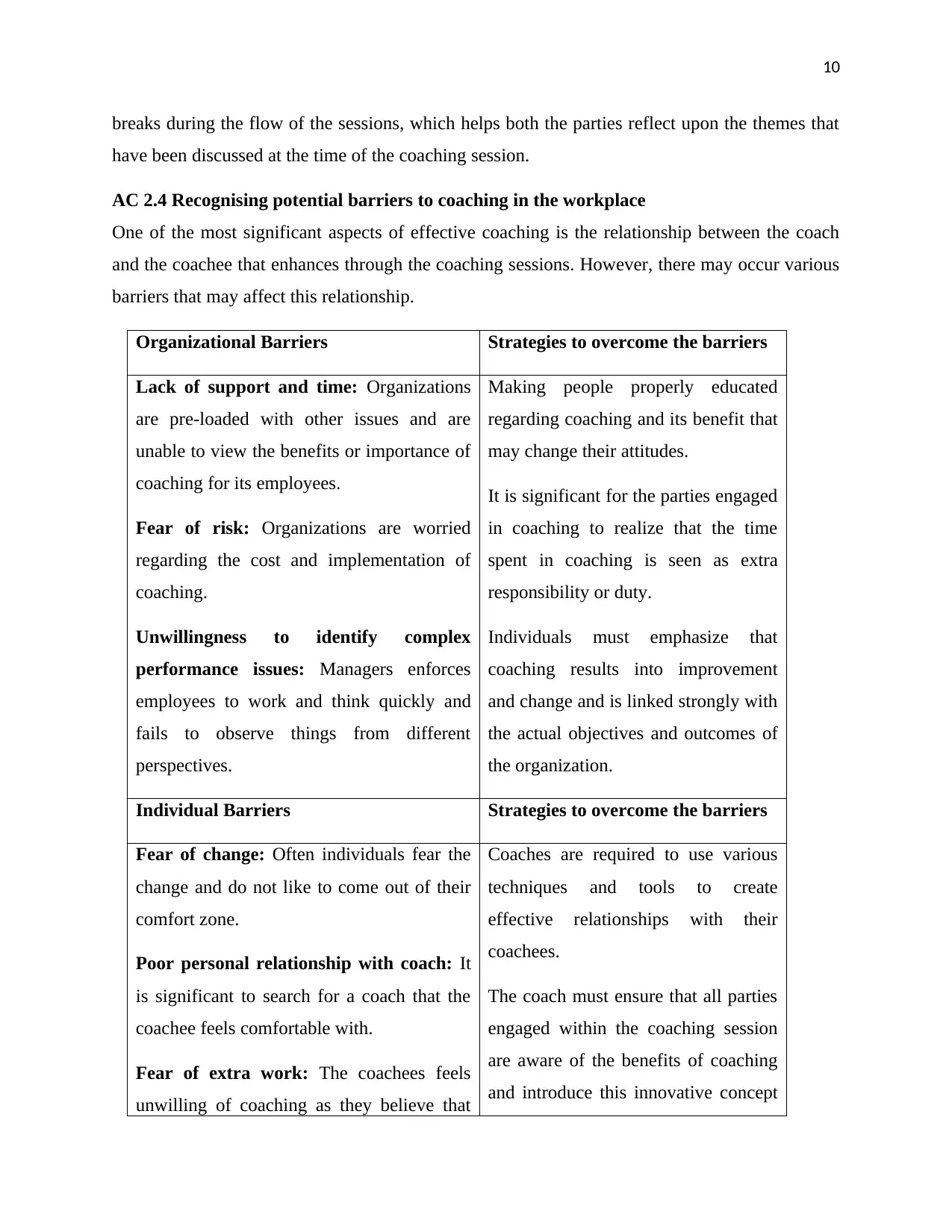
10
breaks during the flow of the sessions, which helps both the parties reflect upon the themes that
have been discussed at the time of the coaching session.
AC 2.4 Recognising potential barriers to coaching in the workplace
One of the most significant aspects of effective coaching is the relationship between the coach
and the coachee that enhances through the coaching sessions. However, there may occur various
barriers that may affect this relationship.
Organizational Barriers Strategies to overcome the barriers
Lack of support and time: Organizations
are pre-loaded with other issues and are
unable to view the benefits or importance of
coaching for its employees.
Fear of risk: Organizations are worried
regarding the cost and implementation of
coaching.
Unwillingness to identify complex
performance issues: Managers enforces
employees to work and think quickly and
fails to observe things from different
perspectives.
Making people properly educated
regarding coaching and its benefit that
may change their attitudes.
It is significant for the parties engaged
in coaching to realize that the time
spent in coaching is seen as extra
responsibility or duty.
Individuals must emphasize that
coaching results into improvement
and change and is linked strongly with
the actual objectives and outcomes of
the organization.
Individual Barriers Strategies to overcome the barriers
Fear of change: Often individuals fear the
change and do not like to come out of their
comfort zone.
Poor personal relationship with coach: It
is significant to search for a coach that the
coachee feels comfortable with.
Fear of extra work: The coachees feels
unwilling of coaching as they believe that
Coaches are required to use various
techniques and tools to create
effective relationships with their
coachees.
The coach must ensure that all parties
engaged within the coaching session
are aware of the benefits of coaching
and introduce this innovative concept
breaks during the flow of the sessions, which helps both the parties reflect upon the themes that
have been discussed at the time of the coaching session.
AC 2.4 Recognising potential barriers to coaching in the workplace
One of the most significant aspects of effective coaching is the relationship between the coach
and the coachee that enhances through the coaching sessions. However, there may occur various
barriers that may affect this relationship.
Organizational Barriers Strategies to overcome the barriers
Lack of support and time: Organizations
are pre-loaded with other issues and are
unable to view the benefits or importance of
coaching for its employees.
Fear of risk: Organizations are worried
regarding the cost and implementation of
coaching.
Unwillingness to identify complex
performance issues: Managers enforces
employees to work and think quickly and
fails to observe things from different
perspectives.
Making people properly educated
regarding coaching and its benefit that
may change their attitudes.
It is significant for the parties engaged
in coaching to realize that the time
spent in coaching is seen as extra
responsibility or duty.
Individuals must emphasize that
coaching results into improvement
and change and is linked strongly with
the actual objectives and outcomes of
the organization.
Individual Barriers Strategies to overcome the barriers
Fear of change: Often individuals fear the
change and do not like to come out of their
comfort zone.
Poor personal relationship with coach: It
is significant to search for a coach that the
coachee feels comfortable with.
Fear of extra work: The coachees feels
unwilling of coaching as they believe that
Coaches are required to use various
techniques and tools to create
effective relationships with their
coachees.
The coach must ensure that all parties
engaged within the coaching session
are aware of the benefits of coaching
and introduce this innovative concept
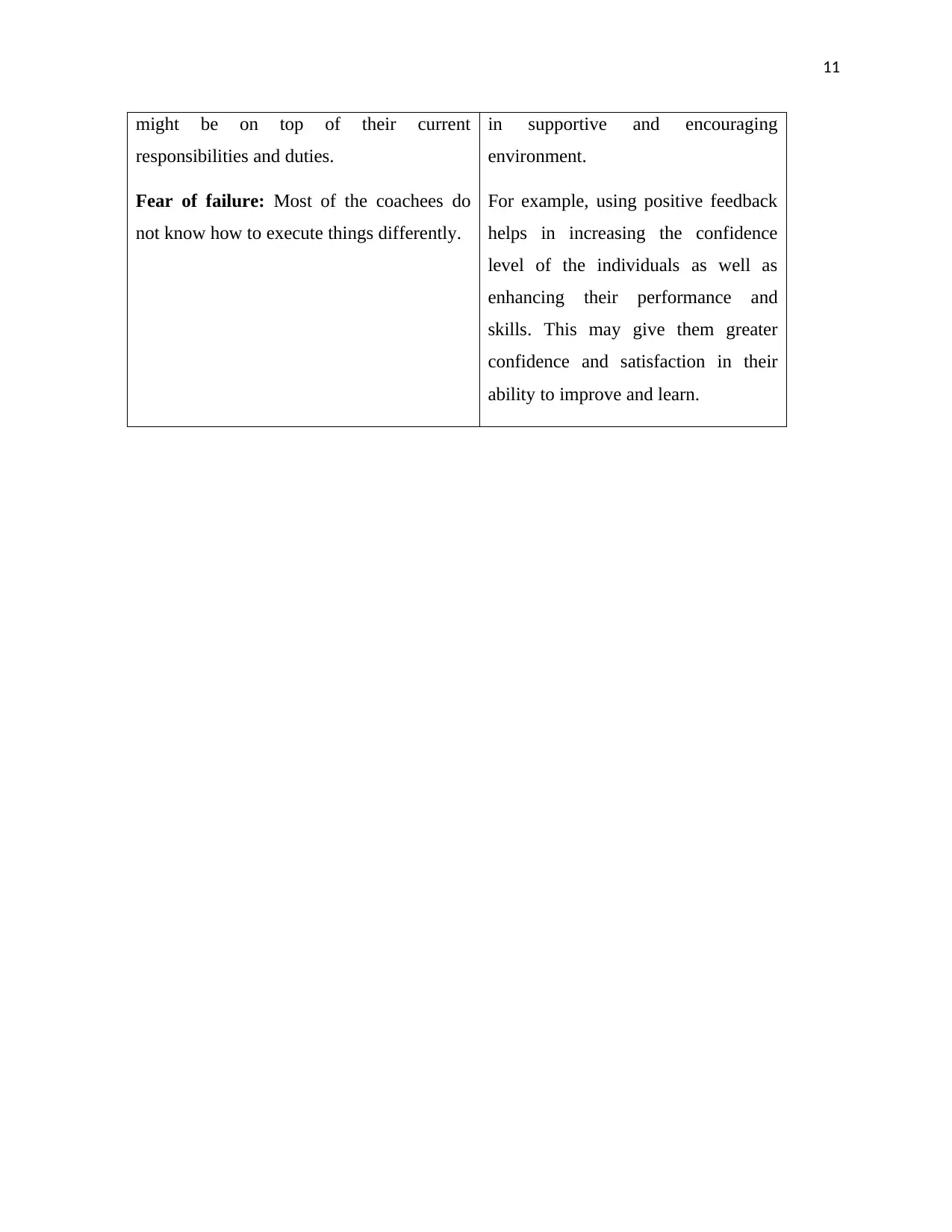
11
might be on top of their current
responsibilities and duties.
Fear of failure: Most of the coachees do
not know how to execute things differently.
in supportive and encouraging
environment.
For example, using positive feedback
helps in increasing the confidence
level of the individuals as well as
enhancing their performance and
skills. This may give them greater
confidence and satisfaction in their
ability to improve and learn.
might be on top of their current
responsibilities and duties.
Fear of failure: Most of the coachees do
not know how to execute things differently.
in supportive and encouraging
environment.
For example, using positive feedback
helps in increasing the confidence
level of the individuals as well as
enhancing their performance and
skills. This may give them greater
confidence and satisfaction in their
ability to improve and learn.
⊘ This is a preview!⊘
Do you want full access?
Subscribe today to unlock all pages.

Trusted by 1+ million students worldwide
1 out of 14
Related Documents
Your All-in-One AI-Powered Toolkit for Academic Success.
+13062052269
info@desklib.com
Available 24*7 on WhatsApp / Email
![[object Object]](/_next/static/media/star-bottom.7253800d.svg)
Unlock your academic potential
Copyright © 2020–2025 A2Z Services. All Rights Reserved. Developed and managed by ZUCOL.





